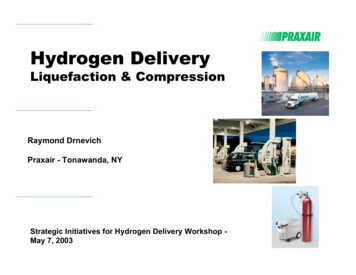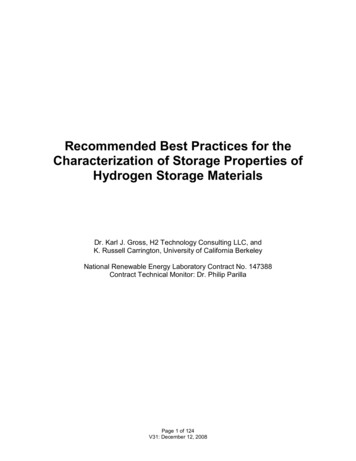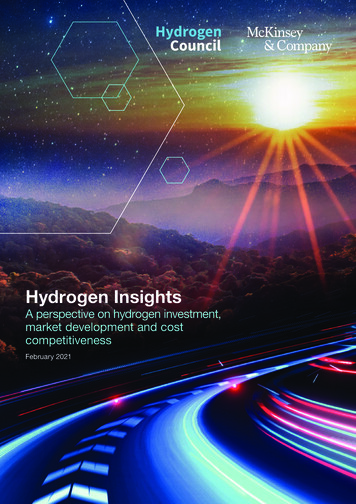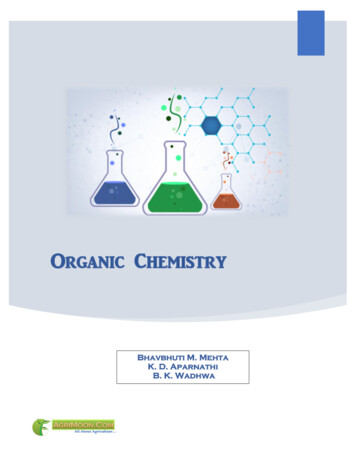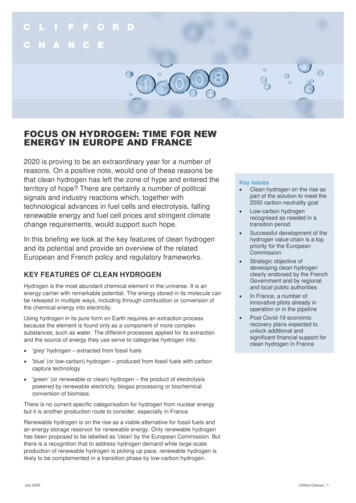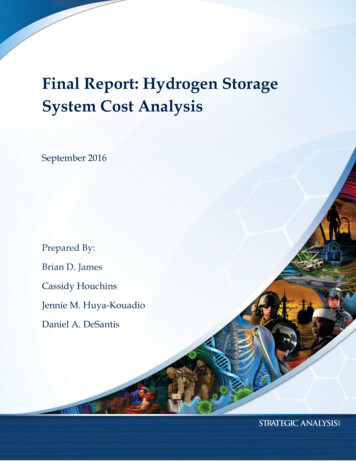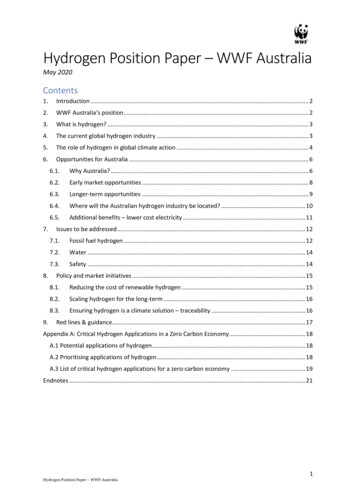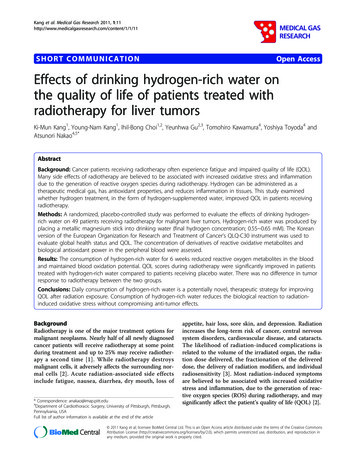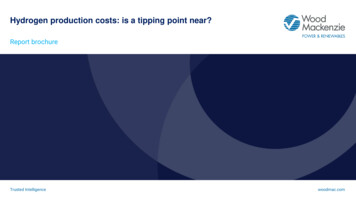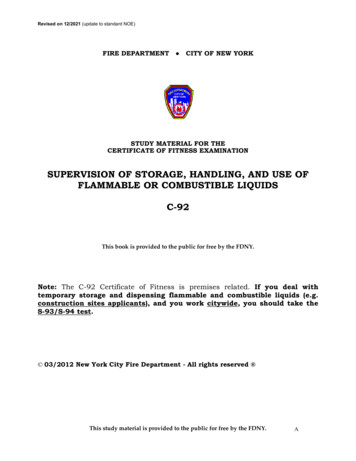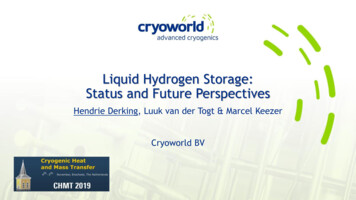
Transcription
Liquid Hydrogen Storage:Status and Future PerspectivesHendrie Derking, Luuk van der Togt & Marcel KeezerCryoworld BV
Cryoworld BVDesign, Engineering, Simulation, Manufacturing, Installation and Testingof high-end cryogenic systems for liquid helium, liquid hydrogen andother liquefied gases.CHMT’19 November 4th, 2019Liquid Hydrogen Storage: Status and future perspectivesH. Derking2
Outline Why hydrogen? Why liquid hydrogen? Design of liquid hydrogen storage tanks Performance of existing liquid hydrogen storage tanks Road to high performance liquid hydrogen storage tanksCHMT’19November 4th, 2019Liquid Hydrogen Storage: Status and future perspectivesH. Derking3
Why hydrogen?Energy density - MJ/kgReducing fossil fuelsVery high energy densityHigh potential for transportation,energy carrier and energy storage140120100806040200“Green” production when using renewable energy sourcesRenewable energysourcesSolarPowerexcess sumedpowerBiomassCHMT’19November 4th, 2019Liquid Hydrogen Storage: Status and future perspectivesH. Derking4
Hydrogen transportation potentialPicture: ToyotaPicture: BMWHydrogenPicture: HyundaiPicture: ESA/CNES/ArianeSpacePicture: AirbusPicture: Sandia National LabPicture: ToyotaCHMT’19November 4th, 2019Liquid Hydrogen Storage: Status and future perspectivesH. Derking5
Hydrogen storageGaseous storageLiquid storageSolid storagePressurized to 700-900 barAt atmospheric pressurePhysisorption in porous materialsStorage at room temperatureStorage at 20.4 KAdsorbed on metal hydridesIn slush to increase densityComplex compoundsMetals and complexes with waterDensity – kg/m380706050403020100CHMT’19November 4th, 2019Liquid Hydrogen Storage: Status and future perspectivesH. Derking6
Liquid versus high-pressure gas storageLiquid storageHigh pressure gas storageDensity70.9 kg/m3 @ 1 bar, 20.3 K39 kg/m3 @ 700 bar, 293 KSafetyLow pressure system with low enthalpy Huge amount of potential energySpill can lead to floor accumulationSpill can lead to jetIntrinsically safe due to vacuum jacket No safety barrierBoil-offEnergy needed 12 kWh/kg for liquefactionbig expensive systemboil-off during no use 6 kWh/kg for compressionsmall less expensive systemNo loss during no useHandlingLiquid to liquid: by pumping or bygravityLiquid to HP gas: by efficient pumpingVery fast fillingSimple logisticsGas to gas: pressure will balanceStorageSingle tankLong thick walled cylinder bundlesCost of storagesystem 300 / kgLong lifespan 900 / kgRelatively short lifespanCHMT’19November 4th, 2019Slow fillingComplex logisticsLiquid Hydrogen Storage: Status and future perspectivesH. Derking7
Liquid hydrogen storage tanksAviationGround-basedRelatively small tank sizeLarge tanksLow weightWeight not very importantNon-vacuum insulatedVacuum-insulatedHigher evaporation could beacceptedZero boil-offMaterials Aluminium alloys Composites Fibre reinforced polymersCHMT’19November 4th, 2019Liquid Hydrogen Storage: Status and future perspectivesH. Derking8
Liquid hydrogen storage tanksPicture: KawasakiPicture: NASANASA, 3800m3 ,270 tPicture: LindePicture: LindeJAXA (Kawasaki), 540 m3, 38 tBoil-off 12% H2LH2 truck, 50 m3, 3.5 tLargest storage tanks constructed for space applications.Spherical shape to optimize surface area to volume ratio.Most tanks made with perlite insulation.Boil-off rates of 1 - 5% / day.CHMT’19November 4th, 2019Liquid Hydrogen Storage: Status and future perspectivesH. Derking9
Heat flow into liquid hydrogen storage tank Insulation: radiation, convection, conduction Conduction through support system–low thermal conductivity materials–high strength materials Conduction through interconnecting piping system–Small cross-section (thin walled pipes)–Increase length Radiation from warmer parts of the container–Shield by using baffles–Optimize design, avoid direct view to warm parts Natural convection in vapour above liquid due toheating Ortho-para conversionCHMT’19November 4th, 2019Liquid Hydrogen Storage: Status and future perspectivesH. Derking10
Optimizing heat flowsNo boiling takes place!All heat entering the liquid is absorbed primarlyby convection.Two types of heat flowsA: heat flows adsorbed in the liquid resulting inevaporation of the liquidB: heat flows adsorbed in the cold vapour.With good design, B heat flows may notcontribute to the evaporation at all.Minimize A heat flows and ensuring adsorbing Bheat flows in cold vapour.CHMT’19November 4th, 2019Liquid Hydrogen Storage: Status and future perspectivesH. Derking11
Ortho-para conversion10096%90OrthoH2Para80Percentage [%]H2In equilibrium:70released energy6050parahydrogen4030201025% para-H2 / 75% ortho-H2 at RT050% para-H2 / 50% ortho-H2 at 77 K05077K99.8% para-H2 / 0.2% ortho-H2 at 20 K100150200Temperature [K]Energy released during full conversion at 20 K is 670 kJ/kg.A catalyst (i.e. Iron(III) oxide) is used to during liquefaction to speed up the transition.A small part ( 4%) of released energy still will be adsorbed in liquid.CHMT’19November 4th, 2019Liquid Hydrogen Storage: Status and future perspectivesH. Derking12250300
InsulationInsulation d fibresSilicaaerogelsPerlite @ 10-2 mbarMultilayer insulation(MLI) @ 10-4 mbarCHMT’19November 4th, 2019k-value(300 – 77 K)[mW/mK] 20 - 50 1.0 -Low weightRelatively cheapEasy to produceHigh heat loadNeed constant purgingStandardtechnologyGood performanceNeeds strong vacuum enclosureHeavy structure0.0065 – 0.1 ExcellentperformanceLiquid Hydrogen Storage: Status and future perspectivesH. DerkingNeeds strong vacuum enclosureHeavy structureMost expensive solution13
Current statusPicture: LindeMost tanks made with perlite insulation, using LN2 technology.Boil-off rates of 1-5% / day.Why LN2 based storage tanks?Picture: Kawasaki- Experience from the past, standard product;- Latent heat of H2 is very high.Liquid @ 1 bar abs.Latent heatTemperature/ thane111.5511.14.220.8HeliumCHMT’19November 4th, 2019JAXA (Kawasaki), 540 m3, 38 tLiquid Hydrogen Storage: Status and future perspectivesH. Derking14
Reducing boil-offThe density of H2 is very low, resulting in a low volumetric latent heat!To reduce the boil-off rate it would be better to use LHe technology:- Multi-layer insulation in combination with high vacuum;- Actively cooled radiation shields.Liquid @ 1 bar abs.Latent heatLatent heat Factor ofTemperature/ massDensity / umCHMT’19November 4th, 2019Liquid Hydrogen Storage: Status and future perspectivesH. Derking15
Two examplesLarge LHe storage @ CERN- Volume:4 x 120 m3- Boil off: 0.20 g/s or 0.12%/daySmall LHe storage @ CERN- Volume: 5 m3Conversion to LH2- 0.01%/day or 0.01 g/sPicture: CERN- Boil off: 0.036 g/s or0.5%/dayConversion to LH2- 0.04%/day or 0.02 g/sCHMT’19November 4th, 2019Liquid Hydrogen Storage: Status and future perspectivesH. Derking16
Conclusions Due to high liquefaction costs, zero boil-off should be the goal forall liquid hydrogen storage tanks. Currently, most ground -based liquid hydrogen storage tanks haveperlite vacuum insulation without active shielding, resulting inboil-off rates of 1-5%/day. Boil-off could be reduced to 0.01-0.05%/day by using storage tanksbased on LHe technology (MLI insulation and active shielding). In case of large storage tanks, boil-off gas could be re-liquefied toreach zero-boil off.CHMT’19November 4th, 2019Liquid Hydrogen Storage: Status and future perspectivesH. Derking17
Thanks for your attention
2 truck, 50 m3, 3.5 t Largest storage tanks constructed for space applications. Spherical shape to optimize surface area to volume ratio. Most tanks made with perlite insulation. Boil-off rates of 1 - 5% / day. Picture: Linde Picture: Linde Picture: NASA Picture: Kawasaki Liquid Hydrogen Storage: Status and future perspectives H. Derking 9 CHMT'19 November 4th, 2019. Heat flow into .
